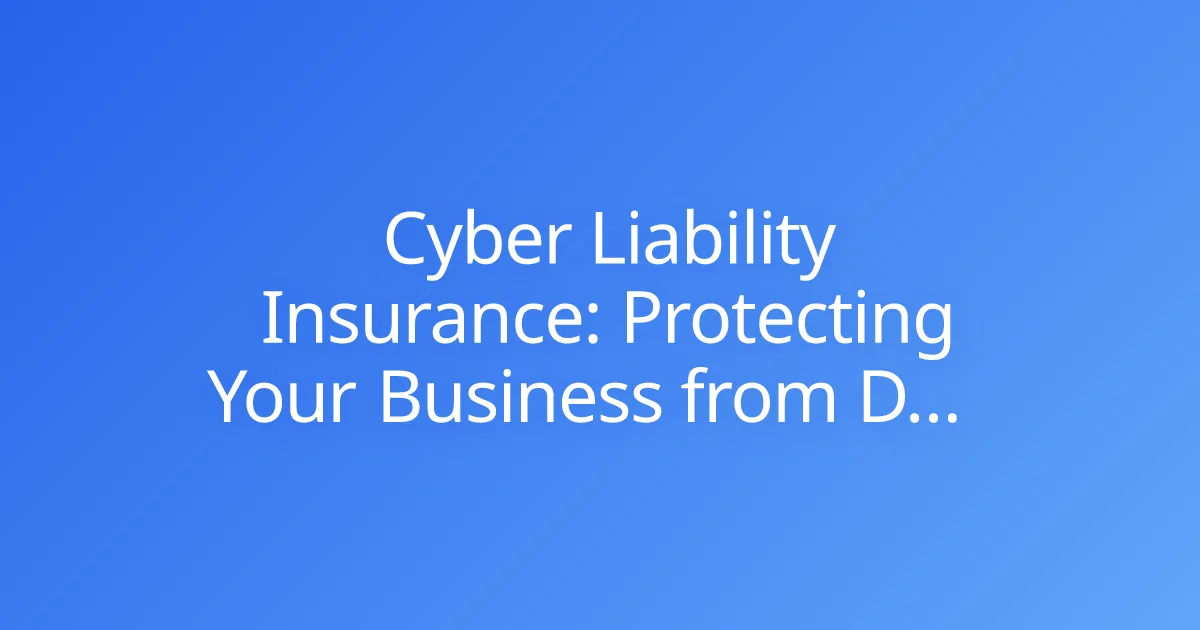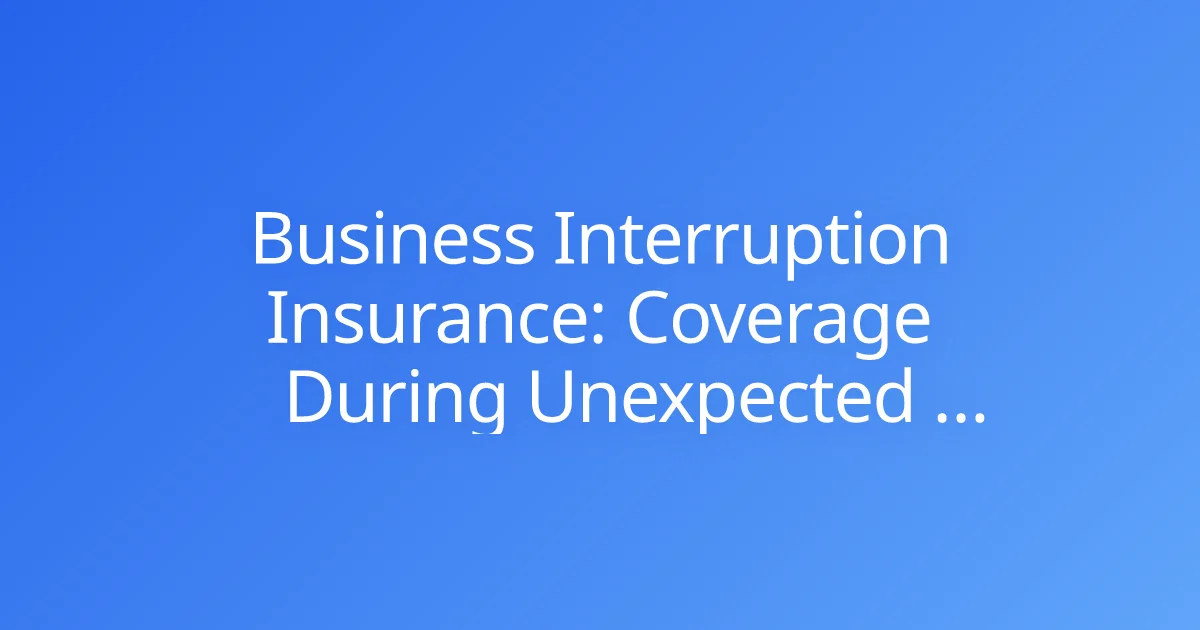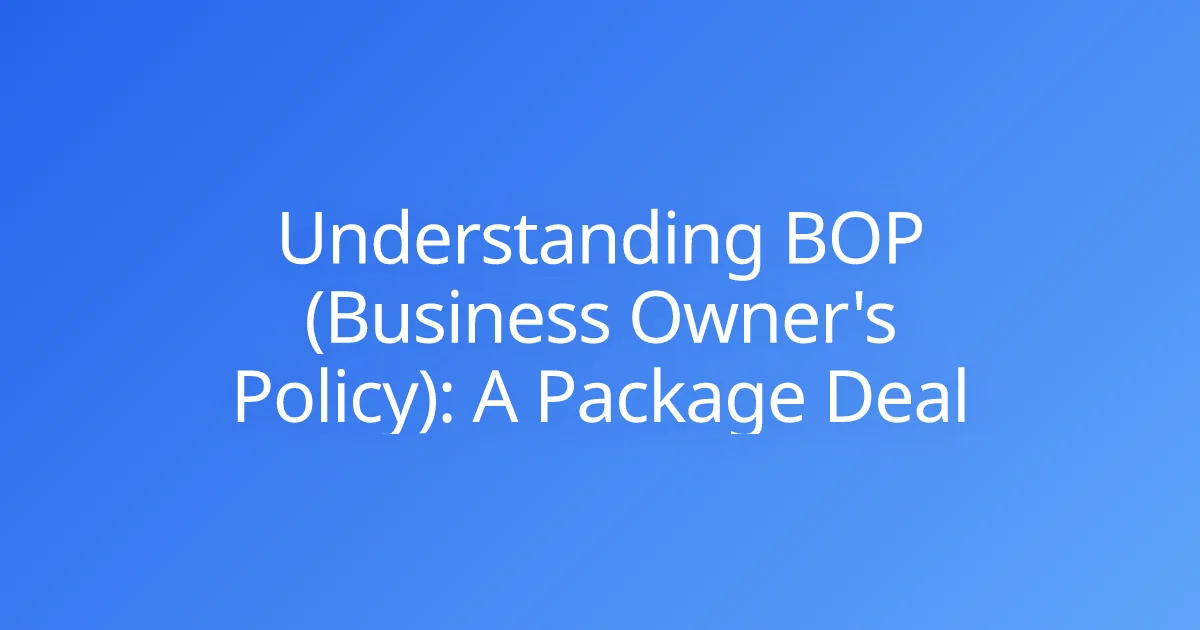Cyber Liability Insurance: Protecting Your Business from Data Breaches
In 2025's interconnected digital world, every business—regardless of size—faces an unprecedented level of cyber risk. The statistics are alarming: 72% of small businesses experienced a cyberattack in 2024, according to the Cybersecurity & Infrastructure Security Agency (CISA), with the average cost of a data breach reaching $4.88 million globally and $165,000 for small to medium-sized businesses.
Consider this real-world scenario: A 25-employee marketing agency in Chicago discovered that ransomware had encrypted all their client files, including sensitive campaign data and customer information for 40+ clients. The attackers demanded $75,000 in Bitcoin. The agency faced:
- $75,000 ransomware payment (after negotiation from $125,000)
- $45,000 in forensic investigation and IT recovery costs
- $38,000 for legal counsel and breach notification expenses
- $52,000 in lost revenue during 3 weeks of partial operations
- $28,000 for credit monitoring services for affected clients
- Total cost: $238,000
Their Cyber Liability Insurance policy, costing just $2,400 annually, covered $225,000 of these expenses, saving the business from bankruptcy.
At The Policy Explainer, we understand the growing complexities of digital risks and the critical need for robust cyber protection. This comprehensive guide will illuminate the essential role of Cyber Liability Insurance in 2025, detailing precisely what it covers, how the threat landscape has evolved, and why this coverage has become non-negotiable for businesses of all sizes.
The 2025 Cyber Threat Landscape: Why Every Business is a Target
Cyberattacks are no longer abstract threats or problems limited to large corporations. They are daily occurrences impacting businesses across all sectors, with small businesses increasingly targeted.
The Escalating Cost of Cybercrime
2025 Statistics That Matter:
- Global cybercrime costs are projected to exceed $10.5 trillion annually by the end of 2025
- Ransomware attacks occur every 11 seconds globally
- The average cost to recover from a ransomware attack is $1.85 million for small businesses
- 60% of small businesses that suffer a major cyberattack close within six months
- Cyberattacks on small businesses increased by 43% from 2023 to 2024
- The average time to identify and contain a breach is 277 days
Why Small Businesses Are Prime Targets
Cybercriminals actively target small and medium-sized businesses because:
- Limited Security Resources: 68% of small businesses lack dedicated IT security staff
- Valuable Data Access: Even small businesses hold customer payment information, personal data, and intellectual property
- Supply Chain Entry Points: Hackers use small businesses as backdoors into larger corporate networks
- Lower Security Awareness: Employees at smaller companies receive less cybersecurity training
- Insurance Gap: 57% of small businesses lack any cyber insurance coverage
Expert insight: "Cybercriminals view small businesses as low-hanging fruit. They have valuable data but often lack the security infrastructure to protect it adequately," notes Sarah Chen, Chief Security Officer at CyberShield Insurance Group.
The Most Common Cyber Threats in 2025
1. Ransomware Attacks
- Frequency: One ransomware attack every 11 seconds globally
- Average demand: $220,000 for small businesses
- Real example: A dental practice in Florida paid $45,000 to recover patient records after all backups were also encrypted
2. Business Email Compromise (BEC)
- Cost: $2.9 billion in losses in 2024 across all businesses
- How it works: Hackers impersonate executives to authorize fraudulent wire transfers
- Real example: An accounting firm wired $125,000 to criminals posing as their CEO
3. Phishing and Social Engineering
- Success rate: 32% of phishing emails are opened by employees
- Impact: Gateway to more severe attacks, credential theft
- Real example: A retailer lost 12,000 customer credit card numbers after an employee clicked a phishing link
4. Supply Chain Attacks
- Growth: Increased 742% since 2021
- Impact: One compromised vendor affects multiple businesses
- Real example: When a major payment processor was hacked, 1,400 small business clients were affected
5. IoT and Connected Device Vulnerabilities
- Risk: Smart office devices, security cameras, and HVAC systems become entry points
- Reality: 98% of IoT device traffic is unencrypted
6. AI-Powered Attacks
- New in 2025: Sophisticated deepfake audio/video for social engineering
- Automation: AI-generated phishing emails with 95% grammatical accuracy
- Scale: Automated vulnerability scanning identifying targets faster than ever
What is Cyber Liability Insurance? Your Digital Shield
Cyber Liability Insurance, also known as cyber insurance or data breach insurance, is a specialized commercial insurance policy designed to help businesses manage the costs and risks associated with cyberattacks and data breaches. It covers expenses that aren't typically covered by General Liability or Property Insurance, which primarily focus on physical damages or bodily injuries.
Think of it as a comprehensive recovery plan for digital disasters. When your data systems are compromised or sensitive information is exposed, Cyber Liability Insurance helps you respond quickly, mitigate damage, and recover financially.
2025 Market Landscape
The cyber insurance market has matured significantly:
- Market size: $11.9 billion globally in 2025, up from $7.8 billion in 2022
- Average premiums: $1,500-7,500 annually for small businesses (under 100 employees)
- Coverage limits: Typically $1M-$5M for SMBs, with larger limits available
- Penetration rate: Still only 43% of businesses carry cyber insurance despite rising risks
- Claims frequency: One in three policies experiences a claim annually
Comprehensive Coverage: What Cyber Liability Insurance Covers in 2025
A robust Cyber Liability Insurance policy offers multiple layers of protection, addressing both first-party costs (your direct expenses) and third-party costs (claims made against you by affected parties).
First-Party Coverage: Direct Response Costs
1. Breach Notification and Crisis Management
- Cost covered: $5-150 per affected individual for notification
- Includes: Legal review, printing, postage, call center services, translation
- Real example: Notification for 10,000 affected customers = $75,000-$250,000
- 2025 requirement: Multi-channel notification (mail, email, website posting) mandated by most states
2. Forensic Investigation
- Typical cost: $15,000-$150,000+ depending on breach complexity
- Covers: IT security experts, digital forensics, root cause analysis, evidence preservation
- Timeline: 2-8 weeks for complete analysis
- Expert insight: Early forensic investigation reduces overall breach costs by 18-22%
3. Credit Monitoring and Identity Theft Protection
- Duration: 12-24 months of monitoring services
- Cost: $15-25 per person annually
- Services: Credit monitoring, identity restoration, fraud alerts, dark web monitoring
- Legal requirement: Mandatory in most states for breach victims
4. Business Interruption and Cyber Extortion
- Coverage: Lost income during system downtime
- Ransom payments: Up to policy sub-limits (typically $100K-$1M)
- Negotiation services: Professional ransomware negotiators included
- Real cost: Average 21 days of downtime = $180,000-$500,000 in lost revenue
- 2025 trend: Some insurers now require multi-factor authentication (MFA) for ransomware coverage
5. Data Restoration and System Recovery
- Covers: Rebuilding databases, restoring lost data, recreating website content
- Typical cost: $25,000-$200,000
- Timeline: 1-12 weeks depending on damage scope
- Includes: Emergency IT services, replacement hardware, software licenses
6. Public Relations and Reputation Management
- Why critical: 83% of customers stop doing business with companies after a breach
- Services: Crisis communications, media training, social media management
- Investment: $15,000-$75,000 for small business campaigns
- ROI: Professional PR can reduce customer attrition by 35-50%
7. Regulatory Fines and Penalties
- GDPR violations: Up to €20 million or 4% of global revenue
- CCPA fines: $2,500-$7,500 per violation
- HIPAA penalties: $100-$50,000 per violation, up to $1.5M annually
- Coverage note: Some fines may not be insurable in certain jurisdictions
8. Cyber Fraud and Funds Transfer Fraud
- Covers: Loss from fraudulent electronic fund transfers
- Typical limits: $100,000-$500,000 sub-limit
- Real example: Business email compromise leading to $250,000 wire transfer to criminals
Third-Party Coverage: Legal Defense and Liability
1. Network Security and Privacy Liability
- Protects against: Lawsuits from customers, clients, business partners
- Covers: Legal defense, settlements, judgments
- Claims for: Failure to prevent data breach, negligent data handling, virus transmission
- Average settlement: $75,000-$350,000 for small business breaches
2. Regulatory Defense and Compliance
- Coverage: Legal representation during government investigations
- Regulatory bodies: FTC, state attorneys general, HHS (HIPAA), international regulators
- Typical legal costs: $50,000-$500,000 for complex investigations
- 2025 focus: Enhanced scrutiny of AI and automated decision-making systems
3. Media Liability
- Digital content risks: Defamation, copyright infringement, invasion of privacy
- Covered platforms: Website, blog, social media, email marketing
- Common claims: Unauthorized image use, defamatory statements, trademark infringement
4. Payment Card Industry (PCI) Fines and Assessments
- When triggered: Breach of credit card data
- Penalties: $5,000-$500,000 depending on breach size and PCI compliance history
- Includes: Card replacement costs, forensic investigation mandated by card networks
Industry-Specific Cyber Insurance Needs
Healthcare Providers (HIPAA-Regulated)
Why critical: Healthcare data breaches cost an average of $10.93 million Key coverage needs:
- HIPAA violation coverage
- Electronic Protected Health Information (ePHI) breach response
- Medical device security incidents
- Telemedicine platform failures
- Business Associate Agreement (BAA) liability
Real example: A 12-physician medical practice faced $385,000 in costs after a ransomware attack compromised 8,500 patient records. Their cyber policy covered all but the $25,000 deductible.
Retail and E-Commerce
Why critical: Handle high volumes of payment card data Key coverage needs:
- PCI-DSS violation coverage
- E-commerce platform downtime
- Point-of-sale (POS) system breaches
- Third-party marketplace incidents (Amazon, Shopify)
- Supply chain cyber incidents
Real example: An online boutique's Shopify store was hacked, exposing 3,200 customer credit cards. Total costs: $147,000. Insurance covered $135,000.
Professional Services (Legal, Accounting, Consulting)
Why critical: Hold highly sensitive client information Key coverage needs:
- Client data breach (tax returns, financial records, legal documents)
- Business email compromise (common attack vector)
- Cloud storage breaches
- Document management system failures
- Client notification and attorney-client privilege protection
Real example: A law firm's document management system was breached, exposing 40 clients' confidential case files. Insurance covered $178,000 in notification, legal review, and reputation management.
Financial Services
Why critical: Regulatory requirements and high-value targets Key coverage needs:
- Regulatory investigation defense (SEC, FINRA, state banking regulators)
- Funds transfer fraud
- Investment data integrity
- Client account takeover
- Insider threat coverage
Manufacturers
Why critical: Operational technology (OT) and industrial control system attacks Key coverage needs:
- Production line disruption
- Intellectual property theft
- Supply chain attacks
- IoT device vulnerabilities
- Safety system compromises
2025 trend: Smart factory cyber-physical attacks increasing 340% since 2022
Technology Companies and SaaS Providers
Why critical: Hold customer data and face service disruption risks Key coverage needs:
- Service-level agreement (SLA) penalty coverage
- Multi-tenant platform breaches
- API security incidents
- Third-party vendor breaches
- Open-source software vulnerabilities
Critical Policy Features to Look For in 2025
1. Incident Response Services
Look for policies that provide 24/7 breach response hotlines with pre-approved vendors:
- Forensic investigators
- Legal counsel specializing in data privacy
- Crisis communications firms
- Ransomware negotiators
Value: Immediate expert access reduces breach resolution time by 40%
2. Pre-Breach Services
Progressive 2025 policies include:
- Annual security assessments
- Employee cybersecurity training
- Phishing simulation testing
- Vulnerability scanning
- Policy reviews and compliance audits
ROI: Businesses using these services see 25-35% lower premiums
3. Retroactive Coverage Date
What it means: Coverage for breaches that occurred before your policy start date but were discovered after Why critical: Average breach detection time is 277 days Typical retroactive period: 30-90 days Expert tip: Negotiate longest possible retroactive date
4. Social Engineering Coverage
Essential in 2025: Covers losses from employee deception (BEC, CEO fraud, invoice manipulation) Typical sub-limit: $100,000-$500,000 Requirement: Often requires MFA and employee training
5. Contingent Business Interruption
Covers: Losses when your vendor or cloud provider experiences a cyber incident 2025 critical need: 89% of businesses rely on cloud services Real example: When a major cloud host went down for 36 hours, 100+ small business clients lost revenue
6. Bricking and System Damage Coverage
New in 2025: Physical damage to hardware caused by cyberattacks Examples: Firmware attacks, nation-state malware, IoT device destruction Typical limit: $50,000-$500,000
Understanding Policy Limits, Deductibles, and Exclusions
Setting Appropriate Limits
Calculation method:
Recommended Minimum Coverage =
(Annual Revenue × 15%) + (Number of Customer Records × $200) + Legal Defense Buffer ($500K)
Example: $2M revenue business with 10,000 customer records:
- Revenue factor: $300,000
- Customer records: $2,000,000
- Legal buffer: $500,000
- Recommended minimum: $2.8M - $3M
Common Deductibles
- Small businesses: $2,500-$25,000
- Mid-size companies: $25,000-$100,000
- Cost impact: Higher deductibles can reduce premiums by 15-40%
Critical Exclusions to Understand
Standard exclusions in most 2025 policies:
- Prior acts (before retroactive date)
- Known vulnerabilities not addressed
- War and terrorism (though standalone coverage available)
- Intellectual property theft by insiders
- Infrastructure failures (unless caused by cyberattack)
- Unencrypted portable devices (in some policies)
- Failure to implement security updates within 30-60 days
- Lack of MFA (increasingly required for ransomware coverage)
2025 trend: Insurers requiring minimum security controls:
- Multi-factor authentication (MFA)
- Endpoint detection and response (EDR)
- Email filtering
- Regular backups (offline/immutable)
- Security awareness training
How Much Does Cyber Liability Insurance Cost in 2025?
Average Premium Ranges by Business Size
Micro-businesses (1-10 employees):
- Annual premium: $500-$1,500
- Typical coverage: $500K-$1M
- Industries: Consultants, freelancers, small agencies
Small businesses (11-50 employees):
- Annual premium: $1,500-$4,500
- Typical coverage: $1M-$2M
- Industries: Retail, professional services, small manufacturers
Medium businesses (51-250 employees):
- Annual premium: $4,500-$15,000
- Typical coverage: $2M-$5M
- Industries: Healthcare, larger retailers, technology companies
Factors Affecting Your Premium
Risk factors that increase costs:
- Healthcare or financial services industry (+30-50%)
- Large customer database (+$0.15-$0.25 per record)
- Previous breach history (+25-100%)
- Lack of MFA or basic security controls (+40-60%)
- Accepting credit cards online (+15-25%)
- Storing sensitive personal information (+20-35%)
Factors that reduce costs:
- Strong cybersecurity posture (-15-30%)
- Regular security audits and training (-10-20%)
- MFA implementation (-10-15%)
- Incident response plan documentation (-5-10%)
- SOC 2 or ISO 27001 certification (-15-25%)
- Claims-free history (-10-15%)
Real-World Case Studies: ROI of Cyber Insurance
Case Study 1: Restaurant Chain Saves $323,000
Business: 8-location casual dining chain, 240 employees Annual premium: $4,200 Incident: POS system breach compromised 15,000 payment cards
Costs incurred:
- PCI forensic investigation: $65,000
- Card brand fines and assessments: $127,000
- Customer notification: $28,000
- Credit monitoring (12 months): $45,000
- Legal fees: $38,000
- PR and reputation management: $32,000
- Total: $335,000
Insurance recovery: $323,000 (after $12,000 deductible) ROI: 7,590% return on premium
Case Study 2: Law Firm Avoids Bankruptcy
Business: 6-attorney law practice Annual premium: $2,800 Incident: Ransomware attack encrypted all case files and client data
Costs incurred:
- Ransomware payment: $45,000
- Forensic investigation: $32,000
- Data restoration: $28,000
- Client notification: $18,000
- Regulatory defense (state bar inquiry): $55,000
- Lost revenue (3 weeks partial closure): $67,000
- Total: $245,000
Insurance recovery: $235,000 (after $10,000 deductible) ROI: 8,293% return on premium Business saved: Without insurance, the firm would have closed
Case Study 3: SaaS Startup Survives Cloud Breach
Business: 25-employee software company Annual premium: $5,600 Incident: Third-party cloud provider breach exposed customer data
Costs incurred:
- Forensic investigation: $48,000
- Customer notification (40,000 affected): $95,000
- Legal fees and regulatory response: $72,000
- Credit monitoring: $80,000
- Business interruption (18 days): $125,000
- PR and customer retention campaign: $45,000
- Total: $465,000
Insurance recovery: $450,000 (after $15,000 deductible) ROI: 7,939% return on premium Customer retention: 82% (vs. typical 45% post-breach without proper response)
Frequently Asked Questions
Q: Is cyber insurance required by law?
A: Not federally mandated, but increasingly required by:
- Contractual obligations: 68% of enterprise clients require vendors to carry cyber insurance
- Professional licensing: Some states require cyber coverage for certain professions (financial advisors, healthcare providers)
- Loan agreements: Many lenders now require cyber coverage for business loans
- Industry standards: PCI-DSS strongly recommends cyber insurance for payment card handlers
Q: Will cyber insurance pay the ransom in a ransomware attack?
A: Most 2025 policies include ransomware coverage, but with conditions:
- Requires consultation with insurance-approved negotiators
- Subject to sub-limits (typically $100K-$1M)
- Increasingly requires MFA and backup protocols to qualify
- Some policies require law enforcement notification
- Coverage decisions made case-by-case based on recovery alternatives
Average 2025 reality: 47% of ransomware cases result in payment, with insurance covering 73% of those payments.
Q: What's the difference between first-party and third-party cyber coverage?
A: First-party covers your direct costs:
- Forensic investigation
- Data restoration
- Business interruption
- Ransomware payment
- Crisis management
Third-party covers liability to others:
- Customer lawsuits
- Regulatory fines
- Legal defense
- Settlements and judgments
Best practice: Ensure adequate limits on both. Most breaches involve both first and third-party costs.
Q: Does cyber insurance cover employee negligence?
A: Yes, most policies cover unintentional employee actions:
- Clicking phishing links
- Misconfiguring systems
- Accidentally sending data to wrong recipients
- Losing unencrypted devices
Not covered: Intentional misconduct, criminal acts, or known vulnerabilities left unaddressed.
Q: How long does it take to get cyber insurance?
A: Application to binding: 1-4 weeks typically
- Simple risks (consultants, small offices): 2-5 business days
- Complex risks (healthcare, large databases): 2-4 weeks
- 2025 trend: Insurers require security questionnaires (30-100 questions) and sometimes network scans
Q: Can I get coverage if I've already had a breach?
A: Possibly, but with conditions:
- Timing: Most insurers require 2-3 years breach-free
- Remediation: Must demonstrate implemented security improvements
- Premium impact: 50-100% higher premiums
- Prior acts exclusion: Previous breach consequences typically excluded
- Reduced limits: Often limited to $500K-$1M initially
Q: What security controls are required to get cyber insurance in 2025?
A: Minimum requirements vary by insurer but commonly include:
- Multi-factor authentication (MFA) for all remote access and admin accounts - Required by 94% of insurers
- Endpoint detection and response (EDR) or antivirus on all devices - Required by 87%
- Regular backups stored offline or immutable - Required by 91%
- Email filtering and anti-phishing tools - Required by 78%
- Security awareness training at least annually - Required by 82%
- Patching protocols for critical vulnerabilities within 30 days - Required by 76%
Emerging 2025 requirements:
- Privileged access management (PAM) for 52% of insurers
- Network segmentation for 43% of insurers
- Incident response plan documentation for 67% of insurers
Best Practices: Maximizing Your Cyber Insurance Investment
Before You Buy
1. Conduct a Cyber Risk Assessment
- Identify what data you collect and store
- Map where data flows in your organization
- Document current security controls
- Identify gaps and vulnerabilities
- Estimate potential breach costs
Free resources: CISA Cyber Resilience Review, NIST Cybersecurity Framework
2. Compare Multiple Quotes
- Get at least 3 quotes from specialized cyber insurers
- Look beyond price—compare coverage breadth, limits, and sub-limits
- Review incident response vendor networks
- Evaluate insurer's claims payment reputation
3. Work with a Specialized Broker
- Cyber insurance complexity requires expertise
- Specialized brokers have access to 15-30 insurers
- Can negotiate better terms and pricing
- Provide ongoing risk management guidance
Industry average: Businesses using specialized brokers get 20-30% broader coverage for the same premium.
After You Buy
1. Implement Required Security Controls
- MFA on all remote access within 30 days
- Deploy EDR within 60 days
- Establish backup regimen immediately
- Schedule quarterly security training
Risk: Failure to implement required controls can void coverage
2. Document Your Security Program
- Maintain evidence of security controls
- Document training completion
- Record patch management activities
- Log security incidents (even minor ones)
Why: Claim disputes often hinge on documented security practices
3. Review and Update Annually
- Business changes require coverage adjustments
- New systems, data, or services create new exposures
- Industry threats evolve rapidly
- Better security posture can reduce premiums
4. Practice Your Incident Response
- Conduct annual tabletop exercises
- Test backups quarterly
- Maintain updated contact lists for insurance breach hotline
- Review and update incident response plan
Result: Businesses with tested IR plans resolve breaches 50% faster
5. Monitor for Emerging Threats
- Subscribe to industry threat intelligence
- Stay informed about new attack vectors
- Update security controls proactively
- Consider cyber insurance policy endorsements for new risks
2025 Cyber Insurance Trends
AI and Machine Learning in Underwriting
- Automated risk scoring: Faster quotes, more accurate pricing
- Continuous monitoring: Some insurers offer real-time security posture tracking
- Predictive modeling: Better identification of high-risk behaviors
Parametric Cyber Policies
- How they work: Automatic payout when predefined trigger occurs (e.g., X hours of downtime)
- Advantages: Faster payment, simpler claims process
- Adoption: Growing from 3% in 2023 to projected 18% by end of 2025
Cyber Warranty Programs
- Concept: Pre-breach security testing and validation
- Benefit: Guaranteed coverage if warranted controls are maintained
- Trade-off: Higher initial scrutiny, better long-term certainty
Regulatory Developments Impacting Coverage
- SEC cyber disclosure rules: Public companies must report material breaches within 4 days
- State privacy laws: 14 states now have comprehensive data privacy laws
- Federal privacy legislation: Potential national standard in development
- International: EU's DORA, NIS2 Directive increasing compliance requirements
Integration with Security Services
- Bundled offerings: Insurance + managed security services
- Prevention focus: Shift from pure risk transfer to risk reduction
- Continuous monitoring: Some insurers provide 24/7 security operations center (SOC) access
Related Insurance Considerations
Cyber Liability Insurance integrates with other essential business coverages:
- General Liability Insurance: Covers physical injury claims, complements cyber coverage
- Professional Liability (E&O): Covers professional service errors (separate from cyber incidents)
- Business Interruption Insurance: Covers physical perils; cyber policies cover digital interruption
- Business Owner's Policy (BOP): May include limited cyber coverage, but standalone policy typically needed
Coverage gap to avoid: Ensure clear understanding where one policy ends and another begins, particularly for cyber-physical incidents.
Conclusion
In 2025's digital-first business environment, Cyber Liability Insurance has evolved from a nice-to-have to an essential component of business risk management. With 72% of small businesses experiencing cyberattacks and average breach costs of $165,000, the question is no longer whether you can afford cyber insurance, but whether you can afford to operate without it.
The sobering reality: 60% of small businesses close within six months of a major cyberattack. Those with comprehensive cyber insurance are 4.5 times more likely to survive and recover fully.
By understanding what it covers, recognizing the evolving threat landscape, implementing required security controls, and choosing the right policy for your business, you create a resilient digital defense strategy. This proactive approach protects not only your financial assets and legal standing but also safeguards your invaluable reputation and ensures the long-term continuity of your business.
Key takeaways for 2025:
- Cyber threats are increasing in frequency and sophistication
- Small businesses are prime targets due to limited security resources
- Cyber insurance provides critical financial protection and expert incident response
- Minimum security controls (especially MFA) are now required for coverage
- Average ROI exceeds 7,000% when claims occur
- Pre-breach services and risk management reduce both incidents and premiums
Next steps:
- Conduct a cyber risk assessment to understand your exposures
- Implement basic security controls (MFA, EDR, backups, training)
- Request quotes from at least 3 specialized cyber insurers
- Review policy terms carefully, especially limits, sub-limits, and exclusions
- Develop and document an incident response plan
- Schedule annual policy reviews as your business evolves
Don't wait for a breach to realize the value of cyber insurance. In today's threat landscape, it's not about if an attack will happen, but when. Protect your business, your customers, and your future with comprehensive Cyber Liability coverage.
Ready to secure your digital assets? Contact a commercial insurance broker specializing in cyber coverage to assess your unique risk profile and get customized protection for 2025's threat landscape.



